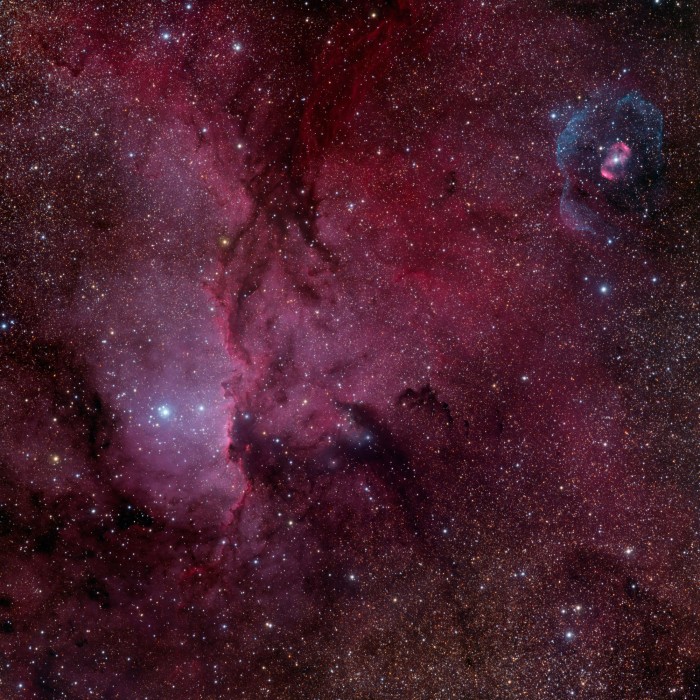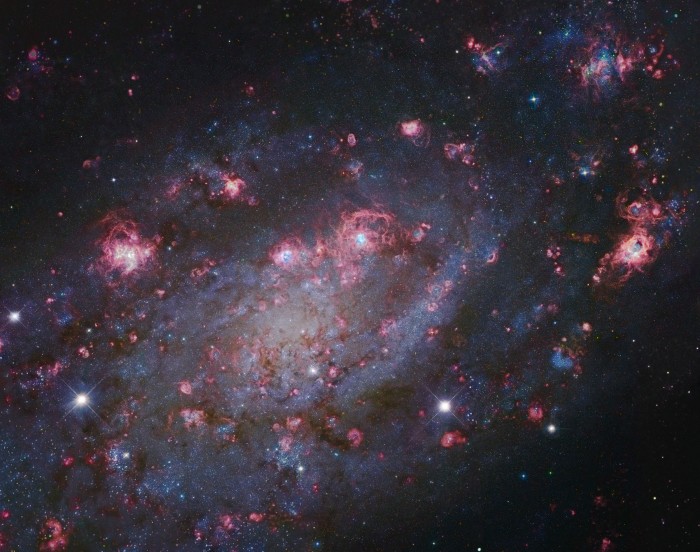NGC 6188 and NGC 6164
From NASA APOD:
Fantastic shapes lurk in clouds of glowing hydrogen gas in NGC 6188. The emission nebula is found near the edge of a large molecular cloud, unseen at visible wavelengths, in the southern constellation Ara, about 4,000 light-years away. Massive, young stars of the embedded Ara OB1 association were formed in that region only a few million years ago, sculpting the dark shapes and powering the nebular glow with stellar winds and intense ultraviolet radiation. The recent star formation itself was likely triggered by winds and supernova explosions, from previous generations of massive stars, that swept up and compressed the molecular gas. Joining NGC 6188 on this cosmic canvas is rare emission nebula NGC 6164, also created by one of the region’s massive O-type stars. Similar in appearance to many planetary nebulae, NGC 6164’s striking, symmetric gaseous shroud and faint halo surround its bright central star at the upper right. The field of view spans about two full Moons, corresponding to 70 light years at the estimated distance of NGC 6188.
Lawrence M. Krauss - Blinded and Blindsided
Theoretical physicist Lawrence M. Krauss has something to say about the dangers of defunding the James Webb Space Telescope:
Almost 20 years ago Congress cancelled what was then the most ambitious scientific project ever launched, the Superconducting Super Collider. Well on the way to completion and after several billion dollars had been spent, cost over-runs and management issues meant that the project, the world’s largest particle accelerator which would have resolved questions ranging from the origin of all mass to the nature of fundamental forces, gave a democratic congress an excuse to kill the program during hard economic times.
A similar situation is arising now and is threatening to ground the nearly completed James Webb Space Telescope. Coming in at $1.6 Billion over its recently updated cost estimate of approximately $5 Billion, this successor to the phenomenally successful Hubble Space Telescope will peer back to the period of ‘first light’, when the first stars and galaxies formed in the universe giving new insights into exotica from the first giant black holes, to the mysterious dark matter and dark energy that dominate the dynamics of the universe. After billions have been spent, the House Appropriations Committee has recommended terminating the project because it is over budget and has had management issues.
The cancellation of the JWST would likely herald the beginning of the end of US leadership in Space Science, just as the cancellation of the SSC moved the center of gravity in particle physics to Europe. The JWST was designed to take off where the Hubble Space telescope—which has revolutionized astronomy—has ended, by taking us to the very beginnings of visible structure in the Universe. It was meant to be the centerpiece of astronomy for the next two decades, and without it, the tantalizing hints that Hubble has been able to glean about our beginnings will remain just that for perhaps a generation.
Indeed, if it were simply a matter of the US taking another step back away from the head of the pack in Science, the proposed cancellation of the JWST would merely be a local tragedy. But the cancellation of such a major international science project, and one for which much of the incredibly sophisticated and expensive infrastructure has already been completed, means it is unlikely that a comparable opportunity will arise elsewhere in the foreseeable future.
The JWST cancellation is part of an overall proposed reduction in support for NASA, which comes on the heels of the end of the Shuttle program, and indeed of the immediate future of human space exploration in this country. Yet when one compares the total cost of the JWST, likely to be around $7 Billion (spent over a period of longer than a decade) with the $200 billion dollar price tag of the Space Shuttle program, and the $100 billion dollar price tag of the International Space Station, and the $ 3 Billion/yr devoted to human launch vehicle development, it seems sad that the item with the greatest potential to push forward the frontiers of knowledge, and the cheapest of the bunch, is being cut.
But the potential loss of the JWST is far greater than just science. It is hard to think of a single NASA project, exceeding even the Mars Rovers, that has captured the imagination of the public, and in particular children, than the images of the cosmos provided by the Hubble Space Telescope. Whenever I lecture and show a Hubble photo I can be guaranteed to provoke excitement and awe. One can only imagine what inspirations the next generation will miss without another comparable eye in the sky.
The Universe is more remarkable than our human imagination alone could have ever guessed, which is why science is more exciting than science fiction. Every time we open a new window on the Universe we are surprised, and each time we learn something new and fundamental about the cosmos we learn something new and exciting about our own origins and our connections to the universe.
It is thus both tragic and frustrated that this tempting and vital new probe of the cosmos may soon be both blindsided and blinded as an unfortunately easy but misplaced target during the current congressional budget cutting frenzy.
NGC 2403 in Camelopardalis
From NASA APOD:
The magnificent island universe NGC 2403 stands within the boundaries of the long-necked constellation Camelopardalis. Some 10 million light-years distant and about 50,000 light-years across, the spiral galaxy also seems to have more than its fair share of giant star forming HII regions, marked by the telltale reddish glow of atomic hydrogen gas. In fact, NGC 2403 closely resembles another galaxy with an abundance of star forming regions that lies within our own local galaxy group, M33 the Triangulum Galaxy. Of course, supernova explosions follow close on the heels of the formation of massive, short-lived stars and in 2004 one of the brightest supernovae discovered in recent times was found in NGC 2403. Easy to confuse with a foreground star in our own Milky Way Galaxy, the powerful supernova is seen here as the spiky, bright “star” at the left edge of the field. This stunning cosmic portrait is a composite of space and ground-based image data from the Hubble Legacy Archive and the 8.2 meter Subaru Telescope at the summit of Mauna Kea, Hawaii.
What NASA Means to America's Future
Neil deGrasse Tyson puts into words perfectly the danger of halting manned spaceflight, and cutting funding to NASA, one of the few, if not the only government agency in America which children admire and use as inspiration for their possible future careers as scientists, engineers, mathematicians, etc.
42
42 years ago today we stepped into the realm of myth and legend.
Of all the events surrounding Apollo 11’s landing on the Moon on July 20, 1969, my most vivid recollection is its unreal quality. Neil Armstrong and Buzz Aldrin shuffled along the gray, dusty lunar surface, the Earth looming large in their sky, while Michael Collins, now the Moon’s own moon, orbited above them in lonely vigil. Yes, it was an astonishing technical achievement and a triumph for the United States. Yes, as Armstrong said as he first alighted, this was a historic step for the human species. But if you turned off the byplay between Mission Control and the Sea of Tranquility, with its deliberately mundane and routine chatter, you could glimpse that we humans had entered the realm of myth and legend.
– Carl Sagan

